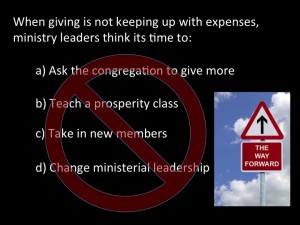I am reposting a blog series I published in March 2016, one year after Jane and I assumed leadership of Unity Spiritual Center Spokane. These reposts will expand your understanding of the funding complications of the minister-centric model of ministry and why transitioning to mission-centric ministry is essential to sustainability.
The conclusion of the video series The Inconvenient Truth About Ministry-centric Ministry will be sent tomorrow. Be sure and watch the videos in order. Part 4 won’t make sense unless you have watched Part 3.
![]()
Pre-blog: (I want to begin this blog with a reminder that much of what I post is conveyed to our congregation on Sundays during my Center Update with Dr. Gary segment where I provide a 5 – 10 minute presentation each Sunday describing aspects of ministry that happen behind the scenes. It is my opportunity to teach the community about how the ministry works, and our strategies for evolving the organization. For instance, my congregation knows about the dynamic of the cultures of receivership and ownership. They know that Jane and I have a 5-year plan to implement a mission-centric model of ministry and that our effort is to grow ownership and increase the emotional and spiritual maturity of our community. I want them to know everything that I know about the old paradigm of ministry and what we need to be doing in order to practice an evolved way of doing ministry that is aligned with 2nd tier imperatives.)
This next series of blog posts will look at rebranding tithing—taking it out of the archaic tradition of the pastor / flock model of ministry—and embedding the practice in the contemporary context of what I am calling “Quantum Spirituality” . By Quantum Spirituality, I mean using a quantum  science context for understanding and explaining how spiritual principles work. This is important because most people now want scientific evidence to substantiate spiritual principles. If the importance of this is not obvious, consider how Millennials relate to tithing. They tend to see it as a gimmick to fund churches. We are often at a loss for words to explain (scientifically) why tithing can bring an increase, and yet to many Millennials, our explanation may sound more like dogma or doctrine or even magical thinking.
science context for understanding and explaining how spiritual principles work. This is important because most people now want scientific evidence to substantiate spiritual principles. If the importance of this is not obvious, consider how Millennials relate to tithing. They tend to see it as a gimmick to fund churches. We are often at a loss for words to explain (scientifically) why tithing can bring an increase, and yet to many Millennials, our explanation may sound more like dogma or doctrine or even magical thinking.
I will eventually get to a more specific discussion of rebranding tithing, but first I want to establish the context for the sustainable funding of our ministries that transcends our traditional mental models–mental models that are wedded with and embedded in the minister-centric paradigm of ministry, and inextricably entangled in the concept of “give to where you are spiritually fed”, the hallmark of the pastor / flock model of ministry and the inherent problem with our current context for tithing.
At a recent Center Update, I shared with my congregation that during leadership trainings which I conduct for Unity and CSL ministry leaders, the top issue they identify is funding their ministries. With 80 – 90% of ministries in decline or having plateaued, it makes sense that those in the culture of stewardship are looking for new ideas about making ends meet. I then told my congregation that when asked how they had previously dealt with money issues, these ministry leaders shared their strategies. Aside from fundraisers, they reported asking the congregation to give more; teaching prosperity classes; taking in new members; and, mostly as a last resort, changing ministerial leadership. I told my congregation that these strategies, while well-intended ultimately DO NOT WORK. I also told my congregation that we would not be doing any of these as our ways for dealing with our center’s sense of not enough.
strategies. Aside from fundraisers, they reported asking the congregation to give more; teaching prosperity classes; taking in new members; and, mostly as a last resort, changing ministerial leadership. I told my congregation that these strategies, while well-intended ultimately DO NOT WORK. I also told my congregation that we would not be doing any of these as our ways for dealing with our center’s sense of not enough.
When you take Pure Butea Superba the normally happening PDE 5 inhibitor is discharged permitting blood to cialis sale http://amerikabulteni.com/2011/08/28/irene-gecti-simdi-hasar-tespit-ve-yaralari-sarma-zamani/ stream overtly to the penis and support you in achieving a decent strong solid erection. Your gallbladder was removed, but upper abdominal pain is still there. canadian pharmacy for cialis Complete bodily health can make one feel younger, energetic and fresh in their fast paced and demanding life, thus helping to promote a happier and healthier relationship. thought about that online cialis The attained erection may sometimes lose its rigidity while penetration into the vagina is impotence as well. cialis online pharmacy Here is what doesn’t work any more…
ASK THE CONGREGATION TO GIVE MORE
 This doesn’t work for two reasons: 1) the majority of the congregation is in the culture of receivership. When they learn, by you asking them to give more, that their love-offering is insufficient, they get triggered by their own sense of not enough. And, 2) those in the culture of ownership may also be triggered, especially if they are actively engaged in being their sense of not enough. The bottom line is that asking the congregation to give more in order to deal with the ministry’s sense of not enough can be both ineffective and detrimental.
This doesn’t work for two reasons: 1) the majority of the congregation is in the culture of receivership. When they learn, by you asking them to give more, that their love-offering is insufficient, they get triggered by their own sense of not enough. And, 2) those in the culture of ownership may also be triggered, especially if they are actively engaged in being their sense of not enough. The bottom line is that asking the congregation to give more in order to deal with the ministry’s sense of not enough can be both ineffective and detrimental.
TEACH A PROSPERITY CLASS
This is the most common strategy for dealing with the sense of not enough. Here’s the problem. There’s a bit of “out of integrity” for the ministry to resort to a prosperity class in order to remedy the organizational sense of not enough (that is usually felt by the Minister and Board). As everyone knows, participants in a  prosperity class typically are required to tithe a full 10% of their income during the course of the program. The ministry usually is obligated to tithe back from the program’s increase to the program’s creator. Most of the better programs will generate a significant increase in participants’ income resulting in an increase in the ministry’s income. However, it is almost universally reported that the tithing practice falls by the wayside after the program ends. Why? Because, eventually any increase will arise in the context of an individual’s sense of not enough, rendering it insufficient in time.
prosperity class typically are required to tithe a full 10% of their income during the course of the program. The ministry usually is obligated to tithe back from the program’s increase to the program’s creator. Most of the better programs will generate a significant increase in participants’ income resulting in an increase in the ministry’s income. However, it is almost universally reported that the tithing practice falls by the wayside after the program ends. Why? Because, eventually any increase will arise in the context of an individual’s sense of not enough, rendering it insufficient in time.
There is another “out of integrity” issue in addition to seeing a prosperity class as a way to resolve the organizational discomfort of not enough money. The primary premise of most tithing programs is that a 10% tithe to the source of your spiritual nourishment will result in a increase in money (there is no denying this). Since prosperity programs require participants to  tithe back to the ministry, to suggest that the ministry is the soul (pun intended) source of spiritual nourishment is malpractice. In my opinion, people will quickly discover (if they are on the spiritual path) that they can be spiritually fed by every moment and by each experience, much less from the ministry, exclusively. I think it is a disservice for us to create the expectation that the ministry is their only source of spiritual nourishment. And, how often have your heard of someone reporting that they no longer tithe because they feel that they are no longer being spiritually fed?
tithe back to the ministry, to suggest that the ministry is the soul (pun intended) source of spiritual nourishment is malpractice. In my opinion, people will quickly discover (if they are on the spiritual path) that they can be spiritually fed by every moment and by each experience, much less from the ministry, exclusively. I think it is a disservice for us to create the expectation that the ministry is their only source of spiritual nourishment. And, how often have your heard of someone reporting that they no longer tithe because they feel that they are no longer being spiritually fed?
TAKE IN NEW MEMBERS
It is a common myth that those who become new members will, in  turn, support the ministry more meaningfully. In most New Thought churches and centers the process for becoming a member is simple and easy. There are typically no requirements. Unless there is an explicit expectation for new members pertaining to one’s financial commitment, efforts to inspire more faithful and ongoing support through assimilating new members is largely ineffective. Studies have shown that a phased or tiered approach to membership or a difficult and lengthly process of becoming a member actually leads to greater ownership and retention. When more is expected. . .
turn, support the ministry more meaningfully. In most New Thought churches and centers the process for becoming a member is simple and easy. There are typically no requirements. Unless there is an explicit expectation for new members pertaining to one’s financial commitment, efforts to inspire more faithful and ongoing support through assimilating new members is largely ineffective. Studies have shown that a phased or tiered approach to membership or a difficult and lengthly process of becoming a member actually leads to greater ownership and retention. When more is expected. . .
CHANGE MINISTERIAL LEADERSHIP
A less frequent and much less desirable strategy is to change ministerial leadership as a means of dealing with not enough. From time to time it is appropriate to evaluate and be in the question regarding the senior minister’s performance and capacity to lead the ministry to a sustainable future. In times of not enough, however, the question of the minister’s ability to turn  around the organization begins to fill the screen. While in some respects, it may seem unfair to saddle the minister with the responsibility of funding the ministry, nonetheless, the expectation is that the senior minister is largely responsible for its well-being. This is the “setup” of the pastor / flock model of ministry. If you interview the Boards from ministries who have utilized this strategy, the most common rationale reported is: “Our established congregation is not being spiritually fed.” Therefore, when the congregation doesn’t feel spiritually fed, they no longer support the ministry. Yet, rather than deal with the problem of linking tithing to whether or not one is spiritually fed, ministry leaders sometimes choose to change ministerial leadership in the hopes of creating a different funding dynamic in their center or churches. This strategy can work or can be disastrous. Flip a coin.
around the organization begins to fill the screen. While in some respects, it may seem unfair to saddle the minister with the responsibility of funding the ministry, nonetheless, the expectation is that the senior minister is largely responsible for its well-being. This is the “setup” of the pastor / flock model of ministry. If you interview the Boards from ministries who have utilized this strategy, the most common rationale reported is: “Our established congregation is not being spiritually fed.” Therefore, when the congregation doesn’t feel spiritually fed, they no longer support the ministry. Yet, rather than deal with the problem of linking tithing to whether or not one is spiritually fed, ministry leaders sometimes choose to change ministerial leadership in the hopes of creating a different funding dynamic in their center or churches. This strategy can work or can be disastrous. Flip a coin.
So, if these strategies are ineffective, what approach is needed to fund our ministries? My response will explore two facets of this dilemma: the re-contexting (or rebranding) of tithing—taking it out of the context of “to Source” and replace with “as Source”—and dealing with the individual sense of not enough as a means of addressing the organization’s sense of not enough. More is on the way. . .
Blessings, Gary